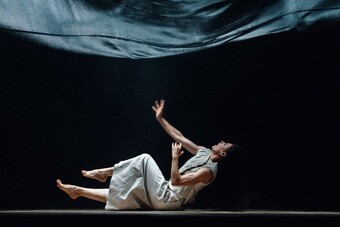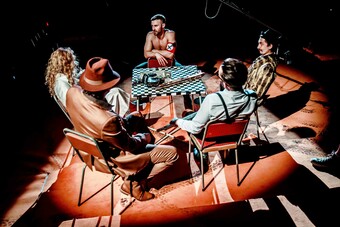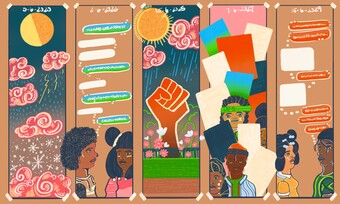A Polish Theater Cookbook
Onstage Diversity in Postwar Society
The lingering effect of last century's Nazi-inflicted ethnic cleansing and the subsequent decades of Soviet occupation is that Poland today lacks much of its historic diversity. But with EU membership, open borders, university exchange programs, and international tourism and travel, the country is recovering its multicultural identity. Many Polish theaters seek to explore Poland's diverse heritage or to connect with other cultures in Europe, but lack immediate access to a large multiethnic pool of actors. Despite the obstacle of recent history, many contemporary Polish theaters present and honor different forms of diversity onstage.
Co-productions or international productions
When Łódź's Teatr Chorea wanted to explore Jewish history, they tapped into the Polish Jewish diaspora and cooperated with Rosanna Gamson/World Wide Dance in Los Angeles, and director Ruthie Osterman from Tel Aviv. Gamson, whose ancestors were Polish Jewish horse traders, co-directed TOV/Dobro ("Good," in Hebrew and Polish), about her family story and the history of wild horses in Europe.
Osterman, whose grandmother is from Łódź, co-directed the site-specific Szpera '42*, about a purge of the Łódź ghetto in September 1942. Israeli, American, and local Polish Jewish performers worked with Chorea artists to portray these stories.**
Similarly, Wrocław's Teatr Zar has created a piece, Armine, Sister, addressing Armenian history and the Armenian genocide. They traveled to visit and study with Armenian singers and cultural elders. Some Armenian musicians returned to Poland to perform with Zar, and became part of the production.
Even a partial exchange, with only a handful of performers, can be significant. When Chorea hosts its biannual festival, Retro//Per//Spectives, many visiting companies (from Belarus, the UK, India, etc.) arrive with only part of their ensemble. The missing roles are filled by local actors in a week of intensive rehearsal before the festival. Chorea gets to work with the visiting performers, not just watch finished pieces.
Diversity of age
People of all ages have diverse histories and talents to bring to the stage. Agnieszka Błońska's Był sobie dziad i baba "Once upon a time there was an old man and an old woman..." (Instytut Teatralny, Warsaw, 2012) was a devised piece for four older dancers. These people talked about their lives as performers, and even performed some of their old routines. They whirled through familiar steps, still agile and energetic. When the dancers got to a difficult move they couldn't complete, they would simply say the name of the step.
Teatr Chorea's Oratorium Dance Project (2011) incorporated families—both parents and children—into the choruses. Simultaneous rehearsals meant that, in effect, day care was provided by the theater (along with training!) while parents worked in a different room. Oratorium included people of all ages in an artistically challenging mainstage production.
Choruses
Many post-Grotowski Polish theaters use forms related to Greek choruses. Chorea's chorus in Szpera '42 had a mix of Jewish and Polish actors. Likewise, the Armine, Sister chorus contained both Armenian and Polish performers. These choruses were sensitively staged and effective. If I had seen a one-person show with a single Polish performer representing another ethnicity, and portraying the history of that culture, I would have questioned it. But I do not question the presence of Polish performers in choruses that also contain Jewish or Armenian performers, in groups portraying those histories. The chorus, when well handled, can expand possibilities for identity representation onstage, going beyond the literal, limited paradigm of one actor=one role.
History on stage, lived experience, and Brechtian signs
Playwright Sebastian Majewski's Transfer! (Wrocław's Teatr Współczesny (Contemporary Theater), 2006), about people displaced after WWII when Poland's borders shifted to the west, was based on interviews with five Germans and five Poles who lived through this time. These people performed their own stories. The production toured for years. Sometimes, due to the illness or death of one of the elderly original cast, an actor had to step in. The replacement performer would have the word AKTOR on their costume. To Majewski, the presence of real living history on the stage was crucial. When the onstage diversity of lived experience was diminished, he wanted the audience to know.
Access to the stage
In the aforementioned Oratorium, children with ADHD and autistic youth took part. These performers took the same workshops and performed in the same pieces with everyone—some have continued to work with Chorea. As with all the young people in Oratorium, initial workshops occurred at their schools, to make the process easily accessible; later, as some of them joined the production, the theater helped to coordinate transport. Chorea has continued to expand access to its stage. Janusz Adam Biedrzycki's Vidomi, which includes blind and visually impaired people as performers and explores the ways in which the entire body, not just the eyes, can "see," premieres this November.
Diversity of living situation, background, and class
Chorea visual artist/curator Paweł Korbus led a piece called Wszędodomni (Home Everywhere) in cooperation with homeless residents in Łódź. The residents told their stories, became part of the performance, and shared the stage with Chorea actors. Korbus has frequently investigated themes of home and belonging: in his group show Dom//Awatar//Translokacja (House//Avatar//Translocation) he installed a decrepit, rotting garden shack in which a homeless man had died in the middle of a gallery, forcing viewers to confront the physical realities of class-based separations within society.
Diversity of language
In Central Europe, where languages have often been officially suppressed by occupying governments, language diversity is meaningful. Theater audiences welcome performances in many languages, with or without titles. This July, Chorea performed their Polish-language Bachantki (The Bacchae) to Carnuntum, Austria; a packed audience enjoyed it without translation. Majewski's Transfer! toured Poland and Germany with supertitles; the performers spoke their native languages.
In 2014, to celebrate "25 lat wolności" (25 years of freedom) a colorful cartoon map of Poland is being distributed. In one corner is a thumbnail showing the seven border nations—including Ukraine. With Putin's expansionism nearby, Poland is conscious of the necessity to find a path forward as a sovereign nation and maintain its hard-won independence. Polish theaters' representations are part of the national effort to retell and re-picture history, imagine an increasingly diverse future for the country, and look forward to many more years of freedom.
***
* From http://www.sztetl.org.pl:
"The word ‘Szpera’ derives from a German phrase ‘Allgemeine Gehsperre’ (an absolute ban on leaving houses and apartments) which was introduced on September 5, 1942 and lasted until September 12. Jewish policemen and German gendarmes searched house after house, took elderly, ill and infirm people as well as children under 10 away..."
** It is important to note that there have been Jews living in Poland throughout all of the twentieth century; the population, though small, is active and growing today. The Kraków Jewish Community Center is one good example.











Comments
The article is just the start of the conversation—we want to know what you think about this subject, too! HowlRound is a space for knowledge-sharing, and we welcome spirited, thoughtful, and on-topic dialogue. Find our full comments policy here